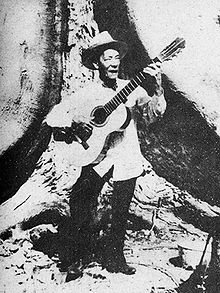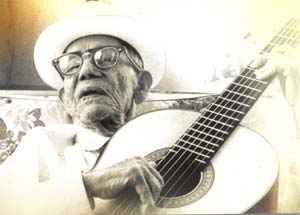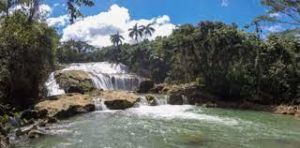PAPA MONTERO, “CANALLA Y RUMBERO”; SU ALEGRE VIDA Y SU EXTRAÑA MUERTE. PHOTOS
Papá Montero, personaje mítico que sirvió de inspiración a poetas, músicos, cineastas, dramaturgos y pintores cuenta que vivió en Isabela de Sagua, singular poblado costero del centro norte de Cuba, a principios del siglo XX.
En aquel universo informal de nuestra patria que es una mezcla del español y el africano, la inspiración del autor de esta historia vino a convertirse con el tiempo en una accion del mas real del criollismo cubano. En aquel universo se han dado vida a algunos protagonistas de obras musicales cubanas como la ‘Maria la O’ de Ernesto Lecuona y el referido ‘Papa Montero’ del popular Eliseo Grenet, cantadas por docenas de orquestas y solistas de todo el mundo.
Según el relato popular este hombre era un gran rumbero, conocido también en Sagua la Grande por su carácter alegre y dispuesto para la fiesta, aún en una avanzada edad, por lo cual se caracteriza con su cabeza cana. Sus dientes eran impecablemente blancos, sombrero de Panamá, camisa guayabera y jeans plisados, y zapatos relucientes de doble color. A este hombre le gusta bailar rumba acompañado de hermosas mulatas y siempre está presente en fiestas y juergas donde encuentra amantes, copas y peleas callejeras.
A este hombre le gustaba estar presente compitiendo con otro amante de la fiesta: José Rosario Oviedo, también conocido como Malanga. Este hombre es el mejor bailarín de la rumba columbia y era lo que en el argot nacional es un “canallita”. Los amigos que conocían el magnifico rumbero competencia a Papá Montero que continuamente eran invitados a cada fiesta de las ofrecidas en el pueblo.
La tradición oral sobre la existencia del referido personaje, recoge que fue asesinado en un carnaval, velorio convertido en un festival de música afrocubana, a lo que aprovechó la esposa insatisfecha con su vida festiva se acercó al ataúd donde sus amigos iban a comenzar a sonar los tambores para acompañar su melodía, y con un fuerte grito dio a conocer todos sus interiores sentimientos hacia el viejo rumbero pícaro, que junto a los toques de tambor y las voces a capella se convirtirian en gustada melodía:
… Y a llorar a Papá Montero zumba, canalla rumbero!
para decir el estribillo “A velar a Papá Montero, ¡zumba! Canalla rumbero”.
Bastardo… .Canalla!
Y todos apoyaron a la vieja dama negra que finalmente habia podido sacar todo esto de su pecho.
Fue ampliamente comentado en la época y el compositor Eliseo Grenet, medio hermano según algunos chismes. El compositor, en la década de 1940, describió el evento en una canción popular, que mostraba cómo los cubanos consideraban incluso la muerte como una broma.
Basta con decir que esta letra ha desencadenado innumerables versiones musicales como Trio Matamoros, Tata Pereira, Antonio Maria Romeu y Maria Teresa Vera. “Papa” fue la canción que levantó la carrera de Grenet, que popularizó canciones como ‘La mora’, ‘Las perlas de tu boca’, ‘El tamalero’, etc.
El protagonista de esta historia dio lugar a muchas leyendas y a la conocida música de Eliseo Grenet, donde las palabras de la cónyugue ofendida con la mencionada frase, se convirtió en repetición en la famosa melodía.Fue ampliamente comentado en la época y el compositor Eliseo Grenet, medio hermano según algunos chismes. El compositor, en la década de 1940, describió el evento en una canción popular, que mostraba cómo los cubanos consideraban incluso la muerte como una broma.
El poeta Nicolas Guillen lo retrata en su poesia:
Bebedor de trago largo
garguero de hoja de lata
en mar de ron barco suelo
jinete de la cumbancha
Mientras el pintor cubano Mario Carreño, plasmó en un óleo “Los funerales de Papá Montero” y Arquímedes Pous, dramaturgo y actor, centró en el personaje obras para el teatro bufo, en la primera mitad del siglo último.
La temática fue llevada al cine por los directores Octavio Cortázar en La última rumba de Papá Montero y por Enrique Pineda Barnet, en La bella del Alhambra , a finales de la centuria precedente, lo cual corrobora la importancia de este personaje.
Nicolás Guillén continua con el recorrido poetico de su muerte:
qué vas a hacer con la noche
si ya no podrás tomártela
ni qué vena te dará la sangre que te hace falta
si se te fue por el caño/ negro de las puñaladas.
Nadie asegura ni niega la existencia real de este hombre, inmortalizado por el arte, parecería que la brisa costera de su poblado natal, aún trasmite el sonido rítmico del tambor rumbero.
PAPA MONTERO, “CANALLA AND RUMBERO”; HIS JOYFUL LIFE AND HIS STRANGE DEATH. PHOTOS
Papá Montero, a mythical character who inspired poets, musicians, filmmakers, playwrights and painters, tells that he lived in Isabela de Sagua, a unique coastal town in the north-central part of Cuba, at the beginning of the 20th century.
In that informal universe of our homeland that is a mixture of Spanish and African, the inspiration of the author of this story came to become over time an action of the most real Cuban Creole. In that universe, some protagonists of Cuban musical works have been brought to life, such as Ernesto Lecuona’s ‘Maria la O’ and the aforementioned ‘Papa Montero’ by the popular Eliseo Grenet, sung by dozens of orchestras and soloists from all over the world.
According to the popular story, this man was a great rumbero, also known in Sagua la Grande for his cheerful character and willingness to party, even at an advanced age, for which he is characterized by his gray head. His teeth were immaculately white, Panama hat, guayabera shirt and pleated jeans, and shiny double-colored shoes. This man likes to dance the rumba accompanied by beautiful mulatto women and he is always present at parties and revelries where he finds lovers, drinks and street fights.
This man liked to be present competing with another party lover: José Rosario Oviedo, also known as Malanga. This man is the best dancer in the Columbian rumba and was what in the national slang is a “little scoundrel”. The friends who knew the magnificent rumbero competed with Papa Montero who were continually invited to every party offered in the town.
The oral tradition about the existence of the aforementioned character, states that he was assassinated in a carnival, a wake turned into an Afro-Cuban music festival, which the wife, dissatisfied with her festive life, took advantage of, approached the coffin where her friends were going to start playing the drums to accompany his melody, and with a loud shout he made known all his inner feelings towards the old roguish rumbero, who together with the drumbeats and the a cappella voices would become a liked melody:
… And to cry to Papa Montero buzzes, rumbero scoundrel!
to say the refrain “Watch out for Papa Montero, buzz! Rumbero scoundrel”.
Bastard… .Scoundrel!
And they all rooted for the old black lady who had finally been able to get all this off her chest.
It was widely commented at the time and the composer Eliseo Grenet, half brother according to some gossip. The composer, in the 1940s, described the event in a popular song, showing how Cubans considered even death a joke.
Suffice it to say that this lyric has triggered countless musical versions such as Trio Matamoros, Tata Pereira, Antonio Maria Romeu and Maria Teresa Vera. “Papa” was the song that raised Grenet’s career, which popularized songs like ‘La mora’, ‘Las perlas de tu boca’, ‘El tamalero’, etc.
The protagonist of this story gave rise to many legends and to the well-known music of Eliseo Grenet, where the words of the offended spouse with the aforementioned phrase became a repetition in the famous melody. It was widely commented at the time and the composer Eliseo Grenet , half brother according to some gossip. The composer, in the 1940s, described the event in a popular song, showing how Cubans considered even death a joke.
The poet Nicolas Guillen portrays him in his poetry:
long drink drinker
tin foil gargle
in sea of rum boat ground
cumbancha rider
While the Cuban painter Mario Carreño, captured in an oil painting “The funerals of Papá Montero” and Arquímedes Pous, playwright and actor, centered on the character works for the comic theater, in the first half of the last century.
The theme was taken to the cinema by directors Octavio Cortázar in La última rumba de Papá Montero and by Enrique Pineda Barnet, in La bella del Alhambra, at the end of the preceding century, which corroborates the importance of this character.
Nicolás Guillén continues with the poetic journey of his death:
what are you going to do with the night
if you can’t take it anymore
nor what vein will give you the blood you need
if you went down the pipe / black from the stab wounds.
No one assures or denies the real existence of this man, immortalized by art, it would seem that the coastal breeze from his hometown still transmits the rhythmic sound of the rumba drum.
Agencies/ Wiki/ PapaMonteroHist./ Extracots/ Excerpts/ Internet Photos/ Arnoldo Varona/ www.TheCubanHistory.com
THE CUBAN HISTORY, HOLLYWOOD.

























